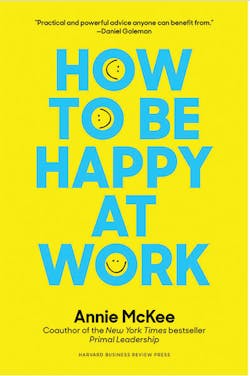Why you should read it: With the labor market tightening and 27% of manufacturing workers over the age of 55, manufacturers face the twin dilemmas of skilled workers retiring at the same time it is increasingly difficult to find their replacements. One remedy is to make the manufacturing workplace more engaging so employees stay and potential employees are attracted to the field.
Problem is, American workplaces generally aren’t doing a good job with employee engagement. Just 33% of employees report being engaged at work, according to Gallup’s State of the American Workplace report. It’s even worse in manufacturing, where only 25% of workers are engaged, the lowest-ranking occupation.
What does this have to do with happiness? Annie McKee is a veteran business consultant and University of Pennsylvania fellow. Her research shows that happiness is intimately linked to performance at work. In her new book, How to Be Happy at Work (Harvard Business Review Press), she points out that more and more of us “think for a living, rather than make for a living, even in manufacturing.” To do that well, she argues, requires workers functioning at a high level.
“People are more effective intellectually, cognitively and in terms of competence on the job when our emotions are largely positive,” she told IndustryWeek.
Managers can’t make workers be happy, but McKee says they can help create an environment where workers have a sense of purpose, share a hopeful vision of the future and have friends.
“You want an environment where people feel largely positive about what they're doing; where they feel enthusiastic and committed; where they feel safe and trusted; where they feel like they're being treated as adults and where they feel like they can make a difference,” she explains. ”When those conditions are in place, when people feel that way, not only are they happy, they're more successful.”
What should a manager do? Step one, says McKee, is to look in the mirror and ask how you’re doing. She notes that depression, stress and other mental health issues are widespread in our society and in the workplace. Managers need to start with being self-aware and ask if they have the kinds of relationships that will allow themselves and others to be successful. Then they need to communicate with employees, letting them know they are interested in creating a better environment for everybody and getting their ideas and buy-in on how to accomplish that.
What about employees? While employers need to create the conditions for a happier, engaged workforce, employees aren’t passive participants, McKee says.
“A lot of people in my experience have bought into an outdated myth that work is supposed to be grueling and it's not supposed to be fun. And I think that's just nonsense actually,” she says. “We spend a third of our waking lives at work at least, not to mention all the time answering calls and doing e-mails on vacation and at night. We have to get rid of the notion that we are supposed to slave and toil in the workplace and earn a paycheck so we can be happy in the rest of our lives.”
What doesn’t work? Don’t pretend to be happy and adopt a “hail fellow, well met” persona.
“Not only won’t people be happy, they're not going to trust you because they can smell a lie a mile away,” McKee says.
And don’t pretend there won’t be rough days in your plant or office.
“Difficulties do arise in the workplace. We have obstacles we have to maneuver through. We have crises. We can't set our sights on a perfect world,” McKee cautions. “Instead we need to ensure that most of the time we're moving toward a more positive, optimistic work environment, and that we have the tools to deal with the problems as they arise so that we can bounce back.”











